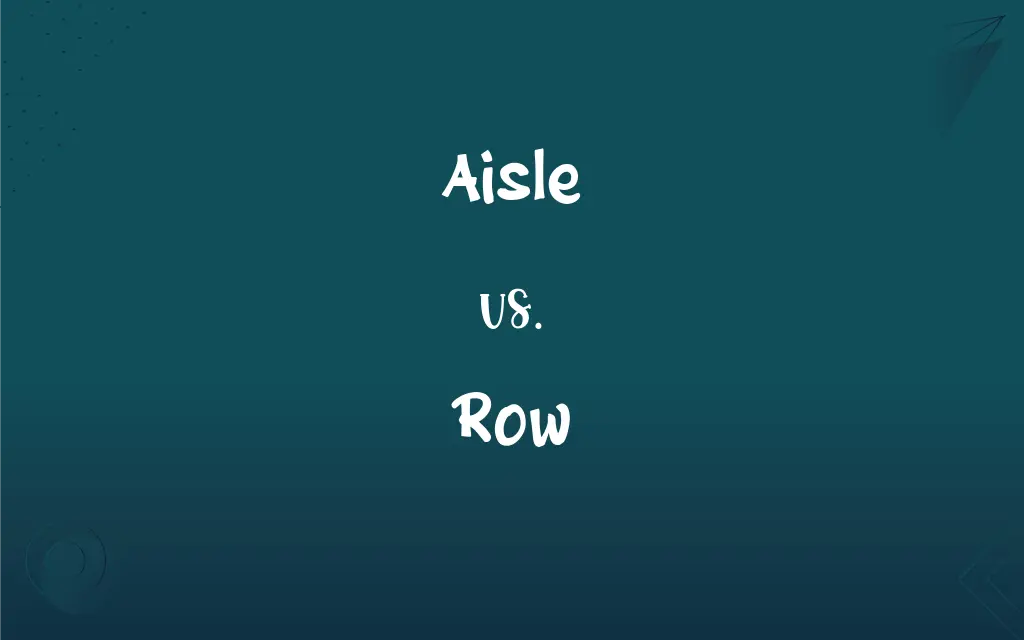Aisle vs. Row: What's the Difference?
Edited by Aimie Carlson || By Harlon Moss || Updated on June 13, 2024
Aisle refers to a passageway between rows, allowing access and movement, whereas a row is a line of seats, objects, or people side by side.

Key Differences
An aisle is specifically designed for movement, providing a clear path for people to walk through, such as in supermarkets, airplanes, and theaters. On the other hand, a row is a series of items or individuals placed next to each other, often used to organize space and facilitate seating or display.
While aisles are essential for navigation and flow within various settings, ensuring safety and accessibility, rows are fundamental for organization, allowing for efficient use of space and orderly arrangement.
In settings like theaters or auditoriums, aisles separate sections of rows, balancing the need for dense seating with the necessity of access and egress. Conversely, each row provides a linear arrangement of seats or items, maximizing capacity within the given space.
The orientation of aisles and rows is crucial for functionality; aisles run perpendicular to rows, facilitating access to each row from a central or side passageway. This interplay ensures that spaces are both accessible and efficiently organized.
Comparison Chart
Definition
A passageway between rows allowing for movement and access
A linear arrangement of seats, objects, or people side by side
ADVERTISEMENT
Purpose
Facilitates movement and access within spaces
Organizes space and maximizes seating or display capacity
Importance
Ensures safety and accessibility in various settings
Fundamental for efficient space utilization and order
Usage Examples
Supermarkets, airplanes, theaters, and auditoriums
Seating in theaters, classrooms, gardens, and product displays
Orientation
Runs perpendicular to rows for efficient access
Placed side by side, often parallel to similar rows for uniformity
Aisle and Row Definitions
Aisle
Used in various settings to ensure accessibility and safety.
Emergency exits were clearly marked along the main aisles of the airplane.
ADVERTISEMENT
Row
A linear arrangement of items or people side by side.
The students sat in neat rows during the assembly.
Aisle
In weddings, refers to the path the bride walks down.
The flower petals were scattered beautifully along the wedding aisle.
Row
In agriculture, refers to a line of plants or crops.
The farmer planted the seeds in long, straight rows.
Aisle
Essential for emergency egress in public spaces.
The building code specified the minimum width of aisles for safe evacuation.
Row
Can indicate a series of objects or elements aligned together.
The library had rows of books stretching from floor to ceiling.
Aisle
A part of a church divided laterally from the nave, transept, or choir by a row of columns.
Row
Used in seating arrangements in theaters, classrooms, and public transport.
We got seats in the front row of the concert hall.
Aisle
A passageway between rows of seats, as in an auditorium or an airplane.
Row
Used to describe a line of houses or buildings.
The colorful row houses added charm to the historic neighborhood.
Aisle
A space between rows or sections for walking or passage.
She walked down the aisle, looking for her seat in the theater.
Row
A series of objects placed next to each other, usually in a straight line.
Aisle
A passageway for inside traffic, as in a department store, warehouse, or supermarket.
Row
A succession without a break or gap in time
Won the title for three years in a row.
Aisle
A wing of a building, notably in a church separated from the nave proper by piers.
Row
A line of adjacent seats, as in a theater, auditorium, or classroom.
Aisle
A clear path through rows of seating.
Row
A continuous line of buildings along a street.
Aisle
A clear corridor in a supermarket with shelves on both sides containing goods for sale.
Row
The act or an instance of rowing.
Aisle
Any path through an otherwise obstructed space.
Row
A shift at the oars of a boat.
Aisle
(transport) Seat in public transport, such as a plane, train or bus, that's beside the aisle.
Row
A trip or an excursion in a rowboat.
Aisle
An idiomatic divide between the Republican Party and the Democratic Party, who are said to be on two sides of the aisle.
Row
A noisy or quarrel or disturbance.
Aisle
The path of a wedding procession in a church or other venue; marriage.
Row
A loud noise.
Aisle
A lateral division of a building, separated from the middle part, called the nave, by a row of columns or piers, which support the roof or an upper wall containing windows, called the clearstory wall.
Row
To place in a row.
Aisle
A long narrow passage (as in a cave or woods)
Row
To use an oar or pair of oars in propelling a boat, typically by facing the stern and pulling the oar handle toward oneself, using an oarlock as a fulcrum to push the blade backward through the water repeatedly.
Aisle
Passageway between seating areas as in an auditorium or passenger vehicle or between areas of shelves of goods as in stores
Row
To propel (a boat) with oars.
Aisle
Part of a church divided laterally from the nave proper by rows of pillars or columns
Row
To carry in or on a boat propelled by oars.
Aisle
Often found in retail to separate product displays for easy navigation.
The grocery store rearranged its aisles to make shopping more efficient.
Row
To use (a specified number of oars or people deploying them).
Row
To propel or convey in a manner resembling rowing of a boat.
Row
To pull (an oar) as part of a racing crew.
Row
To race against by rowing.
Row
To take part in a noisy quarrel or disturbance.
Row
A line of objects, often regularly spaced, such as seats in a theatre, vegetable plants in a garden etc.
Row
A horizontal line of entries in a table, etc., going from left to right, as opposed to a column going from top to bottom.
Row
An act or instance of rowing.
I went for an early-morning row.
Row
(weightlifting) An exercise performed with a pulling motion of the arms towards the back.
Row
A noisy argument.
There was a row among the oarsmen about how to row.
Row
A continual loud noise.
Who's making that row?
Row
To propel (a boat or other craft) over water using oars.
Row
(transitive) To transport in a boat propelled with oars.
To row the captain ashore in his barge
Row
(intransitive) To be moved by oars.
The boat rows easily.
Row
(intransitive) To argue noisily.
Row
Rough; stern; angry.
Row
A noisy, turbulent quarrel or disturbance; a brawl.
Row
A series of persons or things arranged in a continued line; a line; a rank; a file; as, a row of trees; a row of houses or columns.
And there were windows in three rows.
The bright seraphim in burning row.
Row
The act of rowing; excursion in a rowboat.
Row
To propel with oars, as a boat or vessel, along the surface of water; as, to row a boat.
Row
To transport in a boat propelled with oars; as, to row the captain ashore in his barge.
Row
To use the oar; as, to row well.
Row
To be moved by oars; as, the boat rows easily.
Row
An arrangement of objects or people side by side in a line;
A row of chairs
Row
An angry dispute;
They had a quarrel
They had words
Row
A long continuous strip (usually running horizontally);
A mackerel sky filled with rows of clouds
Rows of barbed wire protected the trenches
Row
(construction) a layer of masonry;
A course of bricks
Row
A linear array of numbers side by side
Row
A continuous chronological succession without an interruption;
They won the championship three years in a row
Row
The act of rowing as a sport
Row
Propel with oars;
Row the boat across the lake
FAQs
How do the orientations of aisles and rows relate to each other?
Aisles run perpendicular to rows, providing access to each row from a central or side passageway, ensuring functionality and accessibility.
What is the main function of an aisle?
The main function of an aisle is to provide a passageway for movement and access between rows or sections.
How do aisles contribute to safety in public spaces?
Aisles contribute to safety by ensuring there is a clear path for egress in case of emergencies, allowing people to exit quickly and safely.
How is the number of aisles determined in a venue?
The number of aisles is determined by the size of the venue, the expected number of occupants, and safety regulations to ensure efficient movement and access.
Can a row also serve as an aisle?
Typically, a row does not serve as an aisle because rows are meant for seating or display, not for passage.
Why are rows important in seating arrangements?
Rows maximize seating capacity and organize space efficiently, making it easier to accommodate more people in an orderly manner.
What role do rows play in agriculture?
In agriculture, rows organize crops in a way that maximizes land use, simplifies irrigation, and facilitates harvesting.
Can aisles and rows vary in width and size depending on the setting?
Yes, the width and size of aisles and rows can vary greatly depending on the specific requirements of the setting, such as in airplanes, theaters, or retail spaces.
Are aisles always straight, or can they have different shapes?
While aisles are often straight for ease of navigation, they can also be curved or have varying shapes depending on the design of the space.
How are rows used in data organization?
In data organization, rows represent individual records or data points in a table, allowing for systematic arrangement and analysis.
What considerations are taken into account when designing aisles for public transportation, like airplanes and trains?
Design considerations include the width for comfortable passage, accessibility for all passengers, including those with disabilities, and compliance with safety regulations.
How do aisles enhance the shopping experience in retail stores?
Aisles in retail stores guide customers through the space, making it easier to find products and navigate the store, thereby enhancing the shopping experience.
Can the layout of rows and aisles impact the acoustics of a venue?
Yes, the layout can affect acoustics, especially in theaters and concert halls, where the arrangement of seats (rows) and aisles can influence sound distribution and quality.
How do rows in digital spreadsheets compare to physical rows in seating or agriculture?
Rows in spreadsheets organize data linearly, similar to how physical rows organize people or crops, but they're used for data management rather than physical arrangement.
In what ways do rows and aisles facilitate crowd control in large venues?
They structure the flow of people, directing movement efficiently and preventing bottlenecks, which is crucial for crowd control in large venues.
How does the arrangement of rows and aisles impact the efficiency of space use in parking lots?
Proper arrangement maximizes the number of parking spaces and improves traffic flow, making it easier for vehicles to enter, park, and exit.
Are there cultural or regional differences in how aisles and rows are utilized or perceived?
Cultural and regional differences can influence the design and use of aisles and rows, such as seating arrangements in places of worship or traditional markets.
What role do aisles play in outdoor events, like weddings or festivals?
Aisles play a crucial role in organizing outdoor events by defining spaces, guiding participants and guests, and facilitating movement, contributing to the event's overall flow and order.
What are the challenges in maintaining clear aisles in emergency situations?
Challenges include ensuring aisles are not obstructed by debris or personal belongings and that lighting and signage are adequate for guiding people to safety.
How do rows and aisles contribute to the aesthetic of a space?
Their arrangement can contribute to a space's overall aesthetic by creating patterns, symmetry, and order, enhancing visual appeal.
About Author
Written by
Harlon MossHarlon is a seasoned quality moderator and accomplished content writer for Difference Wiki. An alumnus of the prestigious University of California, he earned his degree in Computer Science. Leveraging his academic background, Harlon brings a meticulous and informed perspective to his work, ensuring content accuracy and excellence.
Edited by
Aimie CarlsonAimie Carlson, holding a master's degree in English literature, is a fervent English language enthusiast. She lends her writing talents to Difference Wiki, a prominent website that specializes in comparisons, offering readers insightful analyses that both captivate and inform.






























































